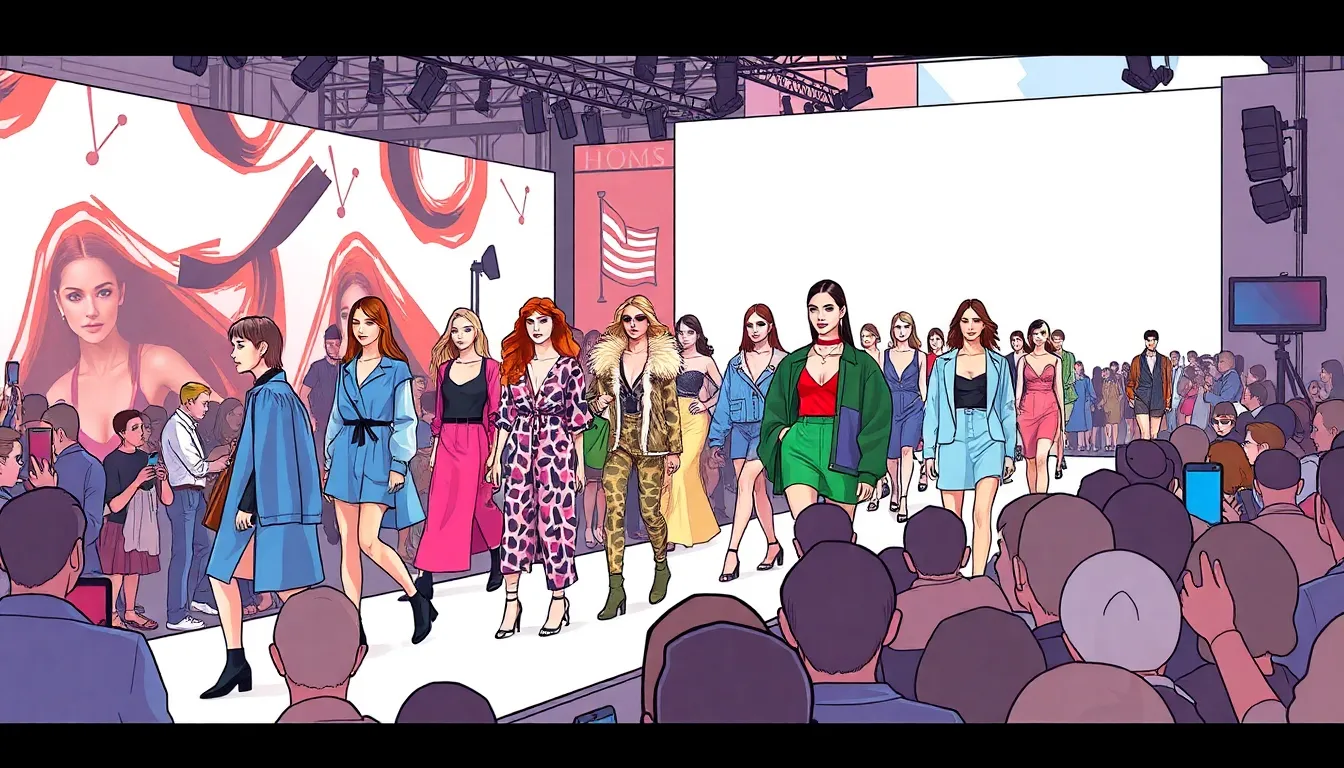In a world where sweatpants have become the new black, fashion coverage in publishing is more crucial than ever. It’s not just about what celebrities are wearing on the red carpet; it’s about capturing the pulse of style that influences everyday choices. From glossy magazines to online blogs, the way fashion is presented shapes trends and sparks creativity.
Table of Contents
ToggleOverview of Fashion Coverage in Publishing
Fashion coverage in publishing encompasses an array of formats that shape and influence public perception of trends. Print magazines, such as Vogue and Harper’s Bazaar, regularly feature articles that highlight seasonal collections and designer interviews. Online platforms, like fashion blogs and social media, generate real-time discussions about street style and emerging trends.
Major events, including Fashion Weeks across cities like New York and Paris, receive extensive media coverage. Such events provide opportunities for publication editors to capture the latest designs and innovations. Even micro-influencers contribute to fashion narratives by sharing personal style tips with niche audiences.
The transition from traditional print to digital has reshaped fashion coverage. Online content often includes videos and interactive elements, making fashion more accessible. Publications engage with audiences through platforms like Instagram, where visual storytelling plays a central role.
Data suggests that 70% of millennials prefer online fashion content over print ads. This shift emphasizes the need for publishing entities to adapt to evolving consumer preferences. Digital platforms enable brands to reach wider audiences quickly, often through influencer partnerships that amplify visibility.
Moreover, inclusivity in fashion coverage has gained traction. Diverse representation in modeling and editorial content reflects broader societal shifts. Many publications now prioritize featuring a range of body types, ethnicities, and gender identities, aligning with consumer demand for authenticity.
Fashion coverage, therefore, serves not only to showcase trends but also to promote dialogue around identity and self-expression. The dynamic landscape of fashion publishing encourages creative freedom and inspires readers to explore their styles.
Historical Context

Fashion coverage in publishing has significantly transformed over time, reflecting societal shifts and evolving tastes. Early fashion journalism in the late 19th century focused on high society, showcasing opulent lifestyles and exclusive designs.
The Evolution of Fashion Journalism
Fashion journalism transitioned from print to digital platforms, with blogs and social media emerging as influential voices. Traditional magazines highlighted seasonal trends, while online content fosters instant engagement with audiences. Fashion influencers on platforms like Instagram and TikTok now shape style narratives, creating authentic connections with diverse audiences. Increased accessibility to fashion information allows individuals to explore styles beyond high-end labels.
Key Milestones in Fashion Publishing
Important milestones mark the history of fashion publishing. Vogue’s inception in 1892 established a benchmark for high-quality fashion coverage. The launch of Harper’s Bazaar in 1867 introduced American audiences to European styles.
In recent years, the rise of digital platforms has revolutionized fashion coverage, making it interactive and instant. Digital-first brands and e-commerce sites contribute significantly to storytelling around fashion. Events like New York and Paris Fashion Weeks garner global media attention, highlighting the latest collections and making trends accessible.
Current Trends in Fashion Coverage
Fashion coverage continues to evolve rapidly with significant trends shaping its landscape.
Digital Transformation and Its Impact
Digital platforms reshaped the delivery of fashion coverage, prioritizing speed and accessibility. Media outlets now leverage social media to provide real-time updates during major events like Fashion Weeks. Online formats enable interactive experiences, allowing readers to engage with content dynamically. Brands utilize video tutorials and streaming events to showcase collections instantly. Research shows that 64% of millennials prefer digital content, driving traditional fashion magazines to adapt. Print publications have begun integrating digital strategies to stay relevant, creating companion apps and interactive features. This transition highlights the importance of embracing technology in capturing contemporary trends.
Influencer Culture and Fashion Media
Influencer culture plays a pivotal role in today’s fashion media landscape. Social media influencers connect followers to brands, offering personal style inspiration directly from diverse perspectives. Statistics indicate that 70% of teenagers trust influencers more than traditional celebrities, elevating their voices in fashion coverage. Various platforms, including Instagram and TikTok, provide influencers with visibility, enabling them to shape trends in real time. This democratization of fashion media encourages more authentic representations and promotes inclusivity. Brands often collaborate with influencers for campaigns, recognizing their significant impact on consumer preferences and buying behaviors.
Challenges in Fashion Coverage
Fashion coverage faces significant challenges in ensuring accurate and engaging content while addressing shifting societal norms.
Maintaining Objectivity in Fashion Reviews
Maintaining objectivity proves difficult for fashion journalists. Personal biases often influence reviews, especially when dealing with high-profile designers or brands. Consistently providing balanced perspectives is essential, as subjective reviews can mislead consumers. Fashion critics sometimes prioritize style over substance, overlooking craftsmanship or ethical considerations. Providing diverse viewpoints encourages a more comprehensive understanding of trends and designs. Readers benefit from honest critiques that help them make informed choices.
The Role of Diversity and Inclusion
Diversity and inclusion have become central themes in fashion coverage. Numerous outlets now prioritize showcasing various body types and ethnic backgrounds to reflect contemporary society. This shift addresses long-standing issues of representation in fashion media, with a growing recognition of the need for authentic voices. Recognizing individuality fosters relatability and resonates with audiences from different demographics. Media coverage that embraces inclusion can significantly influence consumer perceptions and buying habits. Major fashion brands increasingly collaborate with diverse influencers to amplify this inclusive sentiment, transforming the industry landscape.
Future of Fashion Coverage in Publishing
The future of fashion coverage in publishing will likely experience significant transformations as trends evolve.
Predictions for Upcoming Trends
Experts predict increased emphasis on sustainability in fashion media. Brands will prioritize eco-friendly practices, influencing coverage to spotlight ethically produced collections. Growing consumer demands for transparency will drive publications to investigate supply chains and production methods. Furthermore, expect personalized content to rise, tailoring recommendations based on individual preferences. Interactive experiences, like augmented reality, may offer unique ways for audiences to engage with fashion stories. Reports indicate that enhanced digital content formats will continue to dominate, appealing particularly to younger audiences who crave immediate access.
The Influence of Technology and Innovation
Technology plays a central role in transforming fashion coverage. AI-driven algorithms can curate tailored content for readers, ensuring each article aligns with personal interests. Social media innovations allow brands to create real-time storytelling opportunities, enhancing audience engagement. Video content is likely to expand, making collections more accessible and visually appealing. Live streaming events such as Fashion Week will provide audiences with front-row experiences from anywhere in the world. Data-driven insights will further help publishers understand audience behavior, leading to more relevant and impactful fashion journalism.
Fashion coverage in publishing has evolved into a dynamic force that shapes cultural conversations and influences personal style. As it adapts to the digital age the focus on inclusivity and authenticity resonates with diverse audiences. The integration of technology enhances accessibility allowing consumers to engage with fashion like never before.
Looking forward the industry is poised for further transformation with sustainability and ethical practices taking center stage. This shift not only meets consumer demand but also encourages a more responsible approach to fashion. As fashion coverage continues to innovate it will remain a vital platform for self-expression and creativity in an ever-changing world.



